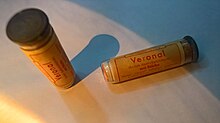 | |
 | |
| Clinical data | |
|---|---|
| Trade names | Veronal, Medinal |
| AHFS/Drugs.com | International Drug Names |
| MedlinePlus | a682221 |
| Routes of administration | By mouth |
| Drug class | Barbiturate |
| ATC code | |
| Legal status | |
| Legal status |
|
| Pharmacokinetic data | |
| Elimination half-life | 30.3 (± 3.2) hours |
| Identifiers | |
| |
| CAS Number | |
| PubChem CID | |
| DrugBank | |
| ChemSpider | |
| UNII | |
| KEGG | |
| ChEBI | |
| ChEMBL | |
| CompTox Dashboard (EPA) | |
| ECHA InfoCard | 100.000.301 |
| Chemical and physical data | |
| Formula | C8H12N2O3 |
| Molar mass | 184.195 g·mol−1 |
| 3D model (JSmol) | |
| |
| |
| (verify) | |
Barbital (or barbitone), sold under the brand names Veronal for the pure acid and Medinal for the sodium salt, was the first commercially available barbiturate. It was used as a sleeping aid (hypnotic) from 1903 until the mid-1950s. The chemical names for barbital are diethylmalonyl urea or diethylbarbituric acid; hence, the sodium salt is known also as sodium diethylbarbiturate.


